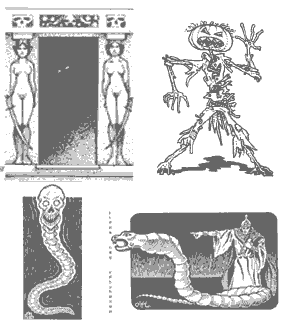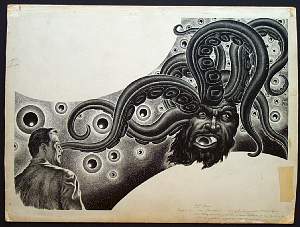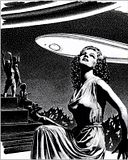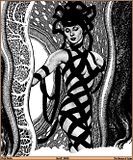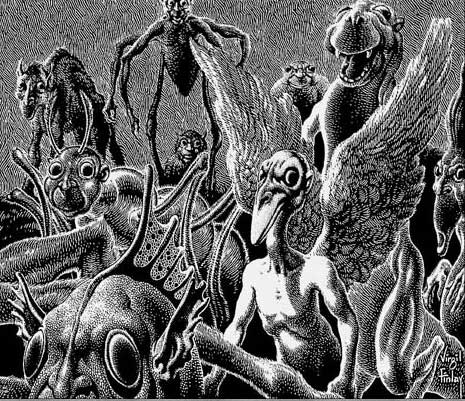 For my money, the price of admission to the Fiend Folio is paid with the Slaadi. Primal chaos in the form of frog-demons whose madness and penchant for destruction is an end in and of itself, led by mad god-like creatures of odd form and inscrutable methods. The slaadi provide a strange, unpredictable force in the world, and hell, their chaos frogs, man. What more do you really want?
For my money, the price of admission to the Fiend Folio is paid with the Slaadi. Primal chaos in the form of frog-demons whose madness and penchant for destruction is an end in and of itself, led by mad god-like creatures of odd form and inscrutable methods. The slaadi provide a strange, unpredictable force in the world, and hell, their chaos frogs, man. What more do you really want?
Friday, January 22, 2010
Fiend Folio Friday
 For my money, the price of admission to the Fiend Folio is paid with the Slaadi. Primal chaos in the form of frog-demons whose madness and penchant for destruction is an end in and of itself, led by mad god-like creatures of odd form and inscrutable methods. The slaadi provide a strange, unpredictable force in the world, and hell, their chaos frogs, man. What more do you really want?
For my money, the price of admission to the Fiend Folio is paid with the Slaadi. Primal chaos in the form of frog-demons whose madness and penchant for destruction is an end in and of itself, led by mad god-like creatures of odd form and inscrutable methods. The slaadi provide a strange, unpredictable force in the world, and hell, their chaos frogs, man. What more do you really want?
Labels:
Fiend Folio,
monsters,
RPG
Wednesday, January 20, 2010
Sorry for the slow posts and lack of responses.
Again, life intrudes. A death in the family, a bit of illness in my sinuses and ears, and the constant grind of graduate school have killed my blogging time, so that only a few art and similar posts have gone up.
Frankly, I'm not too inspired to write right now, but I'll be back to regular posting and responding to posts once things settle down more.
Frankly, I'm not too inspired to write right now, but I'll be back to regular posting and responding to posts once things settle down more.
Friday, January 15, 2010
Fiend Folio Friday
The Fiend Folio had some interesting constructs, too. The scarecrow was of minor interest, but my particular loves from the book were the mid-level danger of Caryatid Columns or the sword and sorcery feel of the Necrophidius and (my personal favorite) the Iron Cobra seemed like perfect elements to throw in as guardians in tombs or servants of evil sorcerers.
Labels:
Fiend Folio,
monsters,
RPG
Monday, January 11, 2010
The Effort of Gaming in a Non-standard Setting
My old friend Dean used to complain about any setting that required a lot of knowledge of setting. "I don't want to read a novel to have to play." Oddly enough, he loved using Forgotten Realms as a setting, but that may be because it was such a generic D&D setting. While you could read a ton about the setting, you didn't necessarily need to do anything other than roll up a character and start playing.
This is always a challenge for home-brew Referees, especially those who use more unusual settings. While the weird and distinctive parts of any setting are what makes it come alive, these things are also the barriers that keep players from feeling like they can just dive in. Consider the difference between Forgotten Realms and say Tekúmel or Glorantha. FR is popular and generally seen as accessible, largely because it seems intuitive to D&D players and anyone who has read a lot of pseudo-Tolkienian heroic fantasy. It's a mish-mash of popular fantasy fiction tropes and contemporary social conventions, and thus is easy to just take in stride. The others have developed societies that seem to have their own cultural assumptions that make it hard to know how to interact. In fact, in Tekúmel, improper social action may have dire consequences — which is certainly where the original idea in the first edition of EPT had characters start out as barbarians.
Now, the original RQ and EPT had far less fluff and developed background than just about any edition of FR. So the truth isn't so much about "reading a novel" as Dean put it, but in how much effort the player has to put in just to do things in character. The real issue is whether playing in your game world is an effort or not. Even if your game s worth the extra work, RPGs are a recreational activity, and as such, it's reasonable to ask if the effort of entry is worth the level of fun had.
The solution is not to eliminate interesting and involved game world background. However, the thing to remember as a referee is that background and immersion are your job to create, rather than putting the onus on players. Structure your early sessions to introduce and reinforce elements of the setting rather than expecting players to read your campaign handout. By giving meaningful demonstrations of the weirdness of the world in-game, then it becomes more real, more manageable, and less like homework.
This is always a challenge for home-brew Referees, especially those who use more unusual settings. While the weird and distinctive parts of any setting are what makes it come alive, these things are also the barriers that keep players from feeling like they can just dive in. Consider the difference between Forgotten Realms and say Tekúmel or Glorantha. FR is popular and generally seen as accessible, largely because it seems intuitive to D&D players and anyone who has read a lot of pseudo-Tolkienian heroic fantasy. It's a mish-mash of popular fantasy fiction tropes and contemporary social conventions, and thus is easy to just take in stride. The others have developed societies that seem to have their own cultural assumptions that make it hard to know how to interact. In fact, in Tekúmel, improper social action may have dire consequences — which is certainly where the original idea in the first edition of EPT had characters start out as barbarians.
Now, the original RQ and EPT had far less fluff and developed background than just about any edition of FR. So the truth isn't so much about "reading a novel" as Dean put it, but in how much effort the player has to put in just to do things in character. The real issue is whether playing in your game world is an effort or not. Even if your game s worth the extra work, RPGs are a recreational activity, and as such, it's reasonable to ask if the effort of entry is worth the level of fun had.
The solution is not to eliminate interesting and involved game world background. However, the thing to remember as a referee is that background and immersion are your job to create, rather than putting the onus on players. Structure your early sessions to introduce and reinforce elements of the setting rather than expecting players to read your campaign handout. By giving meaningful demonstrations of the weirdness of the world in-game, then it becomes more real, more manageable, and less like homework.
Saturday, January 9, 2010
Friday, January 8, 2010
Fiend Folio Friday
Among my favorites in the Fiend Folio were the creepy alien humanoids: the spider-like ettercaps, the two-foot tall, nightmare-sending, body-stealing meenlocks, the astral-hunting berbalang, and the shadow-dwelling (and inexplicably explosive) dark creepers and stalkers.
They added a sense of the alien and inscrutable to the campaign, though the meenlock and berbalang both seemed to be a bit of a one-trick pony, the ettercap made a good recurring monster, and the dark creepers and stalkers made a strong basis for a recurring foe or a level or two of megadungeon theme.
They added a sense of the alien and inscrutable to the campaign, though the meenlock and berbalang both seemed to be a bit of a one-trick pony, the ettercap made a good recurring monster, and the dark creepers and stalkers made a strong basis for a recurring foe or a level or two of megadungeon theme.
Labels:
Fiend Folio,
monsters,
RPG
Tuesday, January 5, 2010
Some random evening thoughts
Getting much of anything done on the blog has been hampered by work (the start of a new term is always a bit of a train wreck), school (only managed to write 25 pages of my dissertation proposal over the holiday and need to really get some meat on the bones of my methodology section), illness (a diagnosis of dermagraphia solves a health mystery, but I also have to deal with a very nasty head cold combined with tension + sinus headache). Sorry for the high level of fluff and low level of response to comments.
Saw Avatar this weekend, and enjoyed it.
Not much in the film was a surprise plot-wise, but the world of Pandora with its alien life a bit too conspicuously built into a seamless whole seems rife for explorating in a sequel (in a proper Burroughsian plot where we learn secrets of the world that the Na'vi never knew before -- perhaps that he world itself is engineered, and Eywa is some artifact of an ancient biotechnology of the Na'vi forerunners... but Jake Sully has to discover this because of a threat from something from the Na'vi's ancient past that even they had forgotten.)
Anyway, that's me checking in. Back to the blog.
Saw Avatar this weekend, and enjoyed it.
Not much in the film was a surprise plot-wise, but the world of Pandora with its alien life a bit too conspicuously built into a seamless whole seems rife for explorating in a sequel (in a proper Burroughsian plot where we learn secrets of the world that the Na'vi never knew before -- perhaps that he world itself is engineered, and Eywa is some artifact of an ancient biotechnology of the Na'vi forerunners... but Jake Sully has to discover this because of a threat from something from the Na'vi's ancient past that even they had forgotten.)
Anyway, that's me checking in. Back to the blog.
Labels:
Personal
Friday, January 1, 2010
Fiend Folio Friday
My favorite Fiend Folio monsters were probably the undead. The Apparition, Coffer Corpse, Death Knight, Huecuva, Pennangalan, Revenant, Skeleton Warrior, and Sons of Kyuss all shared the evocative art of Russ Nicholson, and all seemed to be rotting, filthy and nasty. The Death Knights made great Big Bads, the Coffer Corpse and the Sons of Kyuss regular monsters of the day, and all the rest except for the Pennangalan and the Revenant showed up regularly in dungeons I wrote up.
Most of them had great atmosphere -- the Huecuva was an undead monster who could assume other shapes, the Skeleton Warriors and Death Knights with similar tragic histories, and the creepy worm-addled flesh of the Sons of Kyuss gave enough creepiness to fighting these undead to make them more exciting than having just some more zombies and skeletons.
Most of them had great atmosphere -- the Huecuva was an undead monster who could assume other shapes, the Skeleton Warriors and Death Knights with similar tragic histories, and the creepy worm-addled flesh of the Sons of Kyuss gave enough creepiness to fighting these undead to make them more exciting than having just some more zombies and skeletons.
Labels:
Fiend Folio,
monsters,
RPG
Subscribe to:
Posts (Atom)

